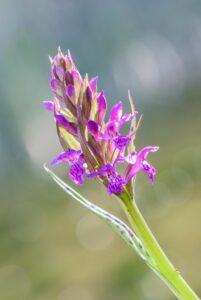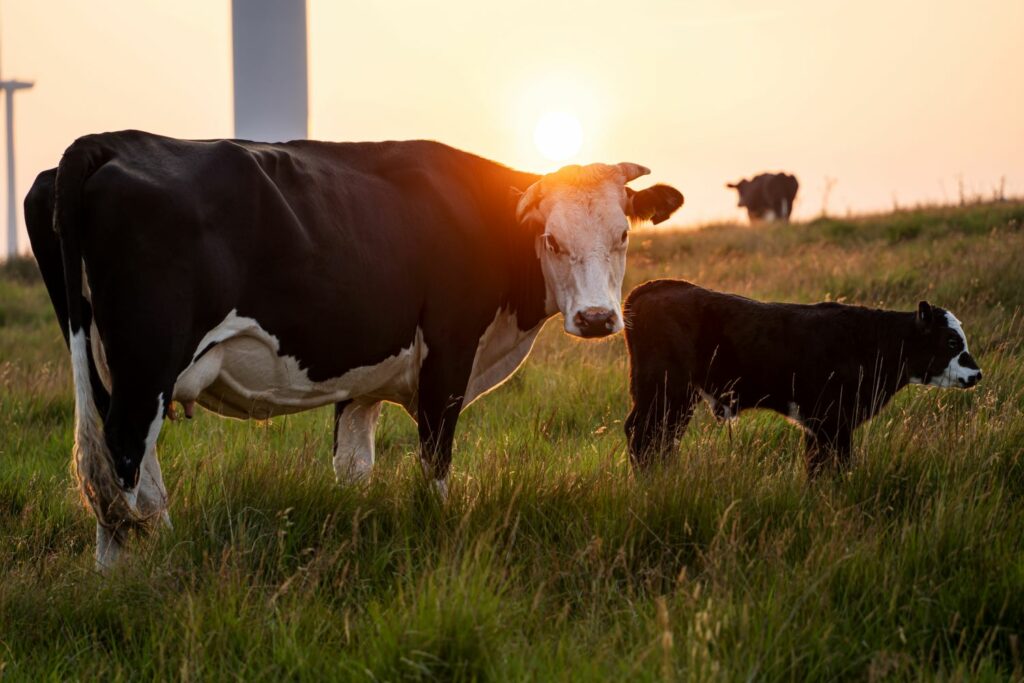A catalyst, not a hindrance: Animal welfare as a key aspect of sustainable food production
17th February 2023
An expert panel at ORFC 2023 discussed how integrating good animal welfare into farming systems can lead to more efficient and profitable food production with reduced environmental impact and an improved reputation of farming in the public eye.
With an overarching theme of promoting agroecology and regenerative farming, animal welfare was on the agenda at the Oxford Real Farming Conference in January 2023. A dedicated session, led by Pasture for Life research manager & Scotland regional facilitator Nikki Yoxall, explored how animal welfare and sustainability can go “hoof-in-hand”.
The first speaker to share her wealth of knowledge was Marthe Kiley-Worthington, an animal welfare scientist, cognitive ethologist, and ecologist, with a background in ecological agriculture spanning 50 years.
Providing more clarity on the term, she explained ecological agriculture “is an ecologically self-sustaining, low-input, economically viable farming system managed to maximise net production without causing large or long-term changes to the environment.”
Since good animal welfare is a vital part of any environmentally conscious farming system, the rest of Ms Worthington’s talk focused on the importance of providing a life of quality to livestock and the benefits of integrating hoofed mammals with agricultural land.
To begin with, she highlighted the shift in focus in animal welfare science in recent decades from identifying and measuring mental distress and physical suffering in animals under human care to providing a life of quality and how to measure this.
Ms Worthington pointed out that the wild as we once knew it no longer exists, as all land is affected by human activities. With the loss of biodiversity exponentially growing, farmers and governments will need to consider ways to prevent the collapse of ecosystems on a global scale.
One such way is the reintroduction of hoofed mammals to a greater proportion of agricultural and common land, she said, as grazing livestock can facilitate the maintenance of diverse ecosystems while generating additional income for farmers.
Ms Worthington explained that the movements and actions of hoofed mammals has a direct effect on the ecosystem and its composition. This is partly due to the variation in the shape, size and weight of hooves between different species that will have different effects on the sward, influencing the insect species that live there.
Moreover, since different species eat different things, co-grazing livestock can encourage certain plants to flourish and apply selective pressure to others.

Broad-leaved marsh orchid native to European meadows and woodland.
In a trial conducted in France, cattle, horses and sheep were rough summer grazed among the wild boar, hares and chamois on 164 ha of mountain nature reserve land. Ms Worthington said the overall species diversity increased as a result, with the rare marsh orchid inhabiting the landscape spreading from 10 to over 20 species.
While grazing animals can be fit into arable rotations and animal and human waste recycled to replace artificial inputs, more trials and research are needed to identify best practices, Ms Worthington said. In particular, more information is required on how many of each species an area of land can sustain to maintain or increase its biodiversity without causing losses to yield, she added.
Addressing the concerningly large amount of food miles spent in feeding our livestock, Ms Worthington concluded her talk on the following note:
“We can model the farming system along the way of the ecosystem so we can be more self-sustaining.”
“Animal welfare shouldn’t be sacrificed for productivity”
The next speaker, Rebecca Mayhew, who farms with her husband in Norfolk, spoke about their transition from an intensive farming system to a much more nature-centric and sustainable enterprise.
Old Hall Farm used to be a very “efficient”, very productive business with intensive arable and indoor pig operations. However, she said the old system was exhausting to maintain and brought little joy to day-to-day life, which is why the couple decided to take 180-degree turn into a whole new direction.
The farm now supports 60 Jersey dairy cows, beef cattle, sheep, goats, rare breed pigs and chickens, with all ruminants 100% pasture fed and pigs and poultry soya free. The cows have their calves at food until they are seven to nine months old, which makes for “less washing up” as the cows are only milked once a day, Ms Mayhew added.
Contrary to the old system, the business now sells all produce direct to customers and is complimented by an on-site farm shop and restaurant. In addition, the farm has an open gate policy starting at 7:30 am, which has generated high levels of public interest and interaction, Ms Mayhew noted.
“The interaction with people and food and the animals that produce the food is crucial,” she said, adding that the business has been gradually moving away from dealing with supermarkets.
Speaking of the way the traditional farming community regards the business, Ms Mayhew pointed out an intriguing controversy: “We are often criticised by other people and farmers that we are not as productive as we used to be, but we feed more people than we ever used to.”
She also spoke of the importance of finding the right balance between the calories that go into producing food and what comes out of it. To maximise yields while staying away from the intensive production system, Ms Mayhew and his husband have been working on vertically stacking enterprises on the farm and making everything as efficient as possible.
Expanding on why she’s committed to 100% pasture fed livestock, she gave the following reasons for adopting the approach:
- Nutrient-dense forage
- Healthy
- Natural
- Cost-effective
- Energy-efficient
- Benefits from ecological services
- We are what they eat
- Reduced environmental footprint
The pastures at Old Hill Farm have been seeded with GS4 herbal leys, which contain 24 different species and have to be resown every five years.
Other than the benefits mentioned above, grazing livestock on diverse forage also makes for an improved attitude towards humans and fewer “rude cows” at milking. Ms Mayhew credits this to the cows being more content and satiated on a diverse forage versus monoculture diet.
As for keeping calves at foot, she believes cows and calves can both be fed on the large scale with the right approach. Due to losing half the milk to the calves on a daily basis, the couple has had to put the price of milk up, which has been well received among customers who witnessed the excellent conditions the animals are being kept in, Ms Mayhew said.
Following the drastic increase in feed costs and the impact of avian flu, the eggs produced on the farm also had to go up in price, but the team of two had nothing but sympathy from customers.
“Animal welfare has a cost and we need to have that conversation with people,” Ms Mahew stressed. “You either drive the cost of welfare and food down, or bring it back up and communicate it to the public.”
The role of animals in sustainable farming futures
Taking to the stage, Nikki Yoxall talked about what animal welfare and sustainability look like on her farm of 100% pasture fed beef cattle in northeast Scotland.
Ms Yoxall believes agroecology goes beyond individual farming units and encompasses the whole food supply web and how farmers interact with customers.
“There is this aspect of the ecology of the entire food system, ideas around justice, and it’s not just about what happens on the farm, it’s about what happened elsewhere. And a very big part of that is who we are as farmers, who our customers are, and how they interact with us,” she remarked.
Expanding on the role of animals in regenerative agriculture, Ms Yoxall said: “Livestock integration represents this opportunity that really enables nutrient cycling through natural processes. And it’s the harnessing of these natural processes that are enabling us to shift towards more sustainable forms of food production and fibre production.
“It’s our role as farmers to enact that sustainable farming future in a way that is ensuring positive welfare and gives all of our farmers and our animals a good life.”
In the remainder of her talk, Ms Yoxall outlined the components of practical agroecology and how they impact sustainability and animal welfare on her farm. The four components are:
- Grazing diverse pastures
- Silvopasture system
- Adaptive multi-paddock grazing
- Family groups, natural weaning
Taking delegates through each element in turn, Ms Yoxall explained species-rich pastures are defined as open, grassy habitats with at least 15 plant species present. Grazing livestock on diverse pastures not only increases biodiversity in agroecological systems, but also supports pollinators, increases soil carbon stocks, and can even reduce the need for bought-in supplements.
Moreover, Ms Yoxall highlighted diverse grazing can also contribute to how content animals are, alongside improving milk and meat quality. She pointed out that like humans, animals also enjoy diversity in their diet, and a “mixed bite” is known to support balanced rumen function.
Meanwhile, a silvopasture system refers to the intentional integration of livestock and trees. It represents a “stacking of enterprises”, she said, and provides more yield from the same area of land.
Silvopasture systems improve farm sustainability by increasing carbon stocks and cycling, as well as enhancing biodiversity and biomass. As trees can provide forage for livestock, they can also reduce the need for additional supplements.
Other than nutrient availability, trees provide shade, shelter, and an opportunity to express natural behaviours for livestock. According to Ms Yoxall, research has shown that grazing mammals exhibit more socio-positive behaviours and stable social hierarchies in silvopasture systems.
Adding to the list of benefits, she noted: “Trees that are high in talin, for example willow and oak, can mean that we don’t need to use any anthelmintics, which spares dung beetles and other dung dwellers and also less inputs to bring onto the farm.”
As for adaptive multi-paddock grazing, the strategy is used to control the impact of livestock grazing and increase rest in the agroecological system, Ms Yoxall explained. Benefits for sustainability include increased carrying capacity per unit of land, extended grazing season, rested areas with more space for wildlife and plant expression.
Adaptive multi-paddock grazing also carries benefits for animal welfare in that it creates a habitual routine, offers a frequent fresh bite and can be altered to meet the needs of livestock.
Lastly, preserving family groups and allowing late or natural weaning (usually at 6-10 months in cattle) reduces stress and creates opportunities for learned behaviour in livestock. It also generates more rest in the system and cuts down supplementary requirements, Ms Yoxall added.
Since the quality of animal welfare influences public opinion of farming, Ms Yoxall encouraged farmers to think about what don’t they want visitors to see and why. Her talk testifies that improving the quality of the animals’ lives that serve us may come at a cost, but will lead to improved contentment, sustainability, and profitability on the long term.

